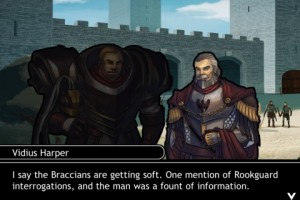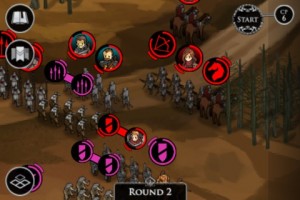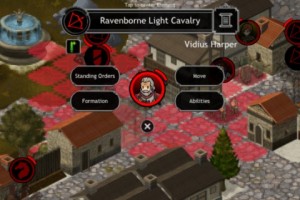Whoever underestimates iOS’ impact on the videogame industry going forward is sorely mistaken. This is no longer only a platform for quick, on-the-go casual games; it’s also the one to flock to if you’re looking for console quality titles that are innovative as they are meaty and mildly priced. Sure, this has already been made clear by the likes of Shadowgun, Anomaly: Warzone Earth, Galaxy on Fire 2, and many others, but also deserving a place on that list is Witching Hour Studios’ Ravenmark: Scourge of Estellion (Out Now, $2.99). Such an ambitious approach to the Turn-Based Strategy genre that isn’t a port? Please pinch me!
Ravenmark’s story begins in medias res, with important characters flying in from every angle as the player begins learning the ropes of its Standing Orders system, but bear with it a few minutes. Taking a page straight out of Final Fantasy Tactics, Witching Hour’s writers plant a number of intriguing questions and then pull back to lay a solid foundation. As we reported in last week’s hands-on preview, this first set of campaigns witnesses the rise of Calius Septim from lowly Earthbound officer to noble Legate in the Empire of the Raven. Between barbarian guerrilla attacks, internal political intrigues, and a displaced nation that wants its old soil back, this empire’s survival is very much in question — and that gives Calius plenty of opportunity to test his smarts on the battlefield.
 Witching Hour amply proves here that a developer doesn’t have to be Square Enix to set a compelling plot in motion and use it to reel the player in. We feel for the meek but intelligent Calius; we look up to his protective elder brother, Rebus; we’re inspired by the cocksure yet amazingly decent Vidius Harper. Not since the golden age of Japanese-produced RPGs and TBSs – filled with greats like Xenogears, Front Mission 3, Final Fantasy Tactics, Vagrant Story, and Tactics Ogre – have I fallen so head over heels for great men and women who exist only as art assets and strings of well-fleshed dialogue. The player doesn’t want these characters to survive just because it’s a gameplay objective; he or she wants them to survive because it’s so easy to get swept up in their world and genuinely care about them. It’s extraordinarily difficult to pull off a story that complements gameplay so well, but Ravenmark makes it look easy.
Witching Hour amply proves here that a developer doesn’t have to be Square Enix to set a compelling plot in motion and use it to reel the player in. We feel for the meek but intelligent Calius; we look up to his protective elder brother, Rebus; we’re inspired by the cocksure yet amazingly decent Vidius Harper. Not since the golden age of Japanese-produced RPGs and TBSs – filled with greats like Xenogears, Front Mission 3, Final Fantasy Tactics, Vagrant Story, and Tactics Ogre – have I fallen so head over heels for great men and women who exist only as art assets and strings of well-fleshed dialogue. The player doesn’t want these characters to survive just because it’s a gameplay objective; he or she wants them to survive because it’s so easy to get swept up in their world and genuinely care about them. It’s extraordinarily difficult to pull off a story that complements gameplay so well, but Ravenmark makes it look easy.
The Standing Orders battle system strikes a balance that’s rare in general, but even more rare in such a complex genre: it feels streamlined and accessible without sacrificing any gameplay depth. Central to the player’s concerns are movement and each unit’s context-sensitive passive and active abilities, all reliably tapped out on sparse radial menus. Many special attacks and abilities have to be carefully engineered; a cavalry unit can execute a deadly feint if it’s sitting next to an enemy and has open ground behind, while rank-and-file swordsmen can become a defensive wall if multiple units are linked together into a column. All enemy and player commands are interleaved in turn order during a Battle Phase, with attacks and counter-attacks happening automatically as units smack into one another. To ensure that a particular unit lands a blow, the player has to check turn order carefully and make sure his or her squads will move out and make contact before the target gets a chance to reposition.
 You might go in expecting lots of swords-and-sorcery trappings – elemental affiliations, area effect spells, etc. – but Ravenmark dodges that fantasy trope by shifting much more weight onto the process of maneuver. The rarity of magic in Estellion makes for less eye candy, but this is a decidedly refreshing approach to the genre that I very much appreciate. The player has to take care that his or her units don’t get flanked or even blocked by enemies in the next turn, and wheeling behemoth columns around becomes dicey on uneven terrain or if the battle becomes sloppy. Waiting a turn, or even moving a unit differently than during a previous attempt, has major repercussions on how the battle will progress — the player can use this to his or her advantage if a particular set of enemies proves tough enough to demand a retry. If a hero unit goes down it’s automatically Game Over, but the player can manually restart the moment things begin to look sour.
You might go in expecting lots of swords-and-sorcery trappings – elemental affiliations, area effect spells, etc. – but Ravenmark dodges that fantasy trope by shifting much more weight onto the process of maneuver. The rarity of magic in Estellion makes for less eye candy, but this is a decidedly refreshing approach to the genre that I very much appreciate. The player has to take care that his or her units don’t get flanked or even blocked by enemies in the next turn, and wheeling behemoth columns around becomes dicey on uneven terrain or if the battle becomes sloppy. Waiting a turn, or even moving a unit differently than during a previous attempt, has major repercussions on how the battle will progress — the player can use this to his or her advantage if a particular set of enemies proves tough enough to demand a retry. If a hero unit goes down it’s automatically Game Over, but the player can manually restart the moment things begin to look sour.
One very important gameplay facet not mentioned in the preview is the fact that the player has a limited number of Command Points to distribute among units during any given Command Phase. This reflects the limited command resources a medieval general would realistically have; you can’t talk to everyone at once! That might sound like a downer, but worry not — this is actually where the Standing Orders system gets its name. The player can stretch his or her command resources by telling a unit to do something, and continue to do it in successive turns at no cost until instructed otherwise. For example, a unit or formation can be instructed to press onward, pursue a particular enemy unit, or remain at rest to recover a few hit points.
 Ravenmark’s interface is about as perfect as it gets on iOS. The player opens a unit’s or formation’s command menu with a virtual button that floats directly above it, and the touch sensitivity on these is perfectly calibrated so they’re reliable without being difficult to pick out when units are smushed together. Even the teeny exit buttons work without a hitch! A Codex detailing the unit’s status and abilities is always one tap away, putting tons of information at the player’s fingertips without a bulky interface cluttering the battlefield.
Ravenmark’s interface is about as perfect as it gets on iOS. The player opens a unit’s or formation’s command menu with a virtual button that floats directly above it, and the touch sensitivity on these is perfectly calibrated so they’re reliable without being difficult to pick out when units are smushed together. Even the teeny exit buttons work without a hitch! A Codex detailing the unit’s status and abilities is always one tap away, putting tons of information at the player’s fingertips without a bulky interface cluttering the battlefield.


